At an MSU lab, the secrets of the atom — and the universe — are being discovered
At a large, new facility on Michigan State University's campus, the boundaries of nuclear science are being taken further than they've ever gone before. And scientists from around the world are lining up to get involved.
MSU's Facility for Rare Isotope Beams, or FRIB, is a three-decade dream. The $730 million facility took almost 14 years to build, and was made possible by more than $635.5 million from the U.S. Department of Energy's Office of Science and $94.5 million from the state of Michigan. The first experiments were conducted at FRIB in May 2022.
FRIB moves stable atoms through a 1,600-foot linear accelerator shaped like a giant paper clip, taking them to half the speed of light to collide with targets and, in a billionth of a trillionth of one second, create rare isotopes almost never seen on Earth.
A 'dream of the nuclear science community'
These exotic isotopes are increasingly found to have specialized applications for health care, national security and industry. But they are also helping scientists understand fundamental questions about the world around us.
"We are exploring, theoretically, the limits of atoms," said FRIB Science Director Brad Sherrill.
"How is the atomic nucleus even possible? Why do atoms exist at all? We want to develop a predictive model of atomic nuclei and how they interact. That turns out to be important for a lot of reasons, not just our fundamental curiosity.
"FRIB is a long-term dream of the nuclear science community of a tool that is really needed."
MSU on Friday announced the commitment of an additional $529 million from the U.S. Department of Energy Office of Science for FRIB to continue its groundbreaking research over the next five years.
The measurements of exotic isotopes that FRIB enables are expected to advance understanding of even more cosmic questions: phenomena such as neutron stars and answers to the origins of our own atoms and elements in the universe.
"As famously noted by the late astronomer Carl Sagan, we are all made of star stuff. Or are we?" said Timothy Hallman, associate director for nuclear physics at the U.S. Department of Energy's Office of Science.
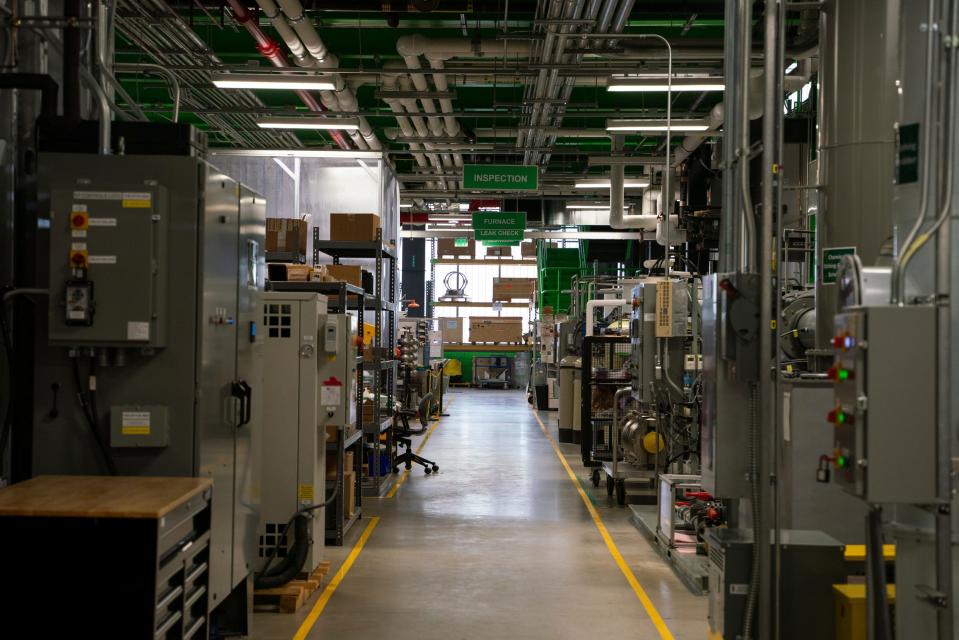
"The elements inside us and around us were produced in the cosmos and not on planet Earth — that’s for sure. But was it in the violent supernovae collapse of stars, or was it in the merger of colliding neutron stars? Or something else completely? The Facility for Rare Isotope Beams was built to answer the processes and location in the cosmos where elements key to our life and existence were forged," Hallman said.
"In the process, it will be a watershed of new knowledge and technology key to other national priorities such as nuclear nonproliferation, nuclear medicine, space exploration and the discovery of physics beyond our current understanding."
'Imagine not having to recharge your phone for, like, nine years'
But for those looking for more down-to-earth applications, FRIB is enabling a line of research at Michigan State into promethium. The isotope promethium 147 holds promise as a nuclear battery.
"Promethium 147 is fantastic because it doesn't have a gamma associated with it really at all, which makes it OK to use around a human," said Alyssa Gaiser, an MSU assistant chemistry professor."So imagine not having to recharge your phone for, like, nine years. Awesome, right?"
It's not explosive
And for those whose alarm for all things atomic was enhanced by the movie "Oppenheimer," rest easy.
An atomic explosion can occur two ways: fusing light things together, like our sun fuses hydrogen to helium; or fissioning heavy things, like uranium, said Thomas Glasmacher, FRIB Laboratory Director.
"But for all of these things, to make an explosion, you need many, many nuclei — you need moles of the stuff," he said.
A mole is a big number; a 6 with 23 zeroes after it. At the most, the FRIB deals with atoms at 10 to the 13th power per second — still a huge number, but 10 zeroes shy of being anywhere near atomic explosion range.
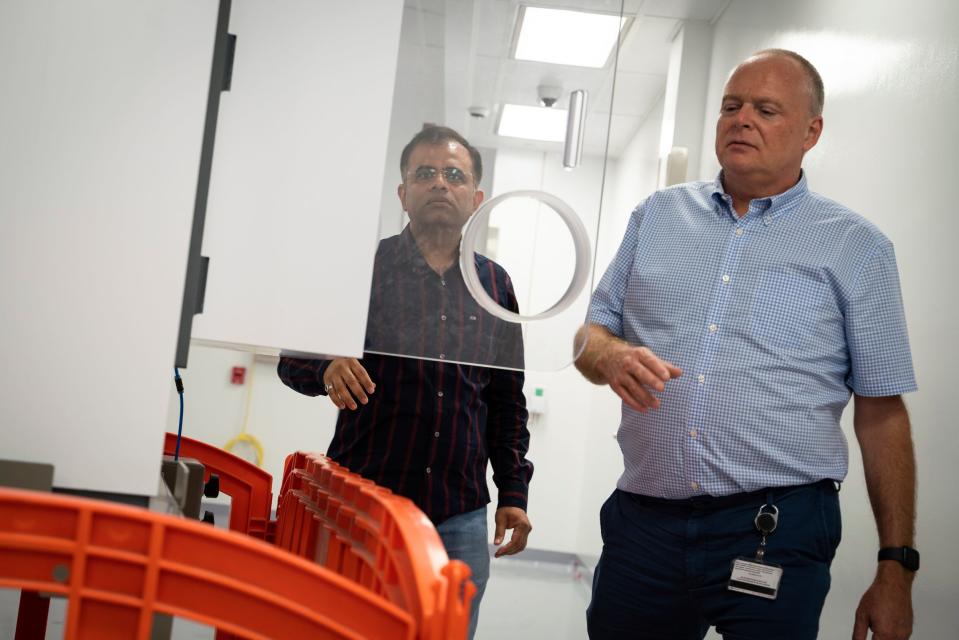
"We have such small amounts, we just can't do it — we wouldn't do it," he said with a laugh, "But we are physically unable to do it."Similarly, the FRIB activities also don't pose a potential radioactivity hazard like a nuclear power plant, as there is no ongoing radioactivity, he said.
"We are not a reactor; we are an accelerator," he said. "We are sticking energy in to smash those atoms. But when the energy stops, the acceleration stops."
Isotopes: Same element, different nuclear structure
To better understand what MSU's FRIB does and why, let's go back to physical science class. You — and everyone and everything around you — are made of atoms. They are the smallest units of matter. They consist of an inner nucleus made up of positively charged protons; neutrons that have no charge; and surrounded by a cloud of electrons with a negative charge.
The same element can be built in slightly different ways atomically, depending on the number of neutrons in its nucleus. Those different atoms, with different numbers of neutrons but the same chemical properties, are isotopes. For example, carbon occurs naturally in three isotopes: carbon-12, which has six neutrons (plus six protons equals 12; hence the number), carbon-13, which has seven neutrons, and carbon-14, which has eight neutrons.
Those one or two extra neutrons can make the properties of isotopes quite different from one another. Carbon-12 is stable, meaning it never undergoes radioactive decay. But carbon-14 is unstable and undergoes radioactive decay with a half-life of about 5,730 years, meaning that half of the material will be gone after 5,730 years. This decay means the amount of carbon-14 in an object tells its age, which is why archaeologists and similar science fields use carbon-14 dating.
Many isotopes are very unstable and can exist in that form for only a very short time; others can last billions of years. Gold has 40 known isotopes, and another 20 not yet seen but theorized by scientists to exist. But only one is stable and typically encountered; the naturally occurring gold that makes necklaces, rings and watches.
Many unstable isotopes give off radioactive energy as they decay. And science and industry have figured out how to put that to use. An isotope of the element fluorine, known as Fluorine-18, is frequently used in medical PET scans. Its radioactivity lasts long enough to generate body scans for health professionals, but dissipates within two hours, making it safer to use with patients.
How it works — and why it's so cold
The FRIB moves stable atoms through a gas of electrons, which removes the atom's electrons, creating a positively charged ion. Those ions are then guided into the linear accelerator, where they are moved through 46 cryomodules across a superconducting material, speeded ever faster through alternating voltages — eventually up to about half the speed of light, which is 186,000 miles per second.
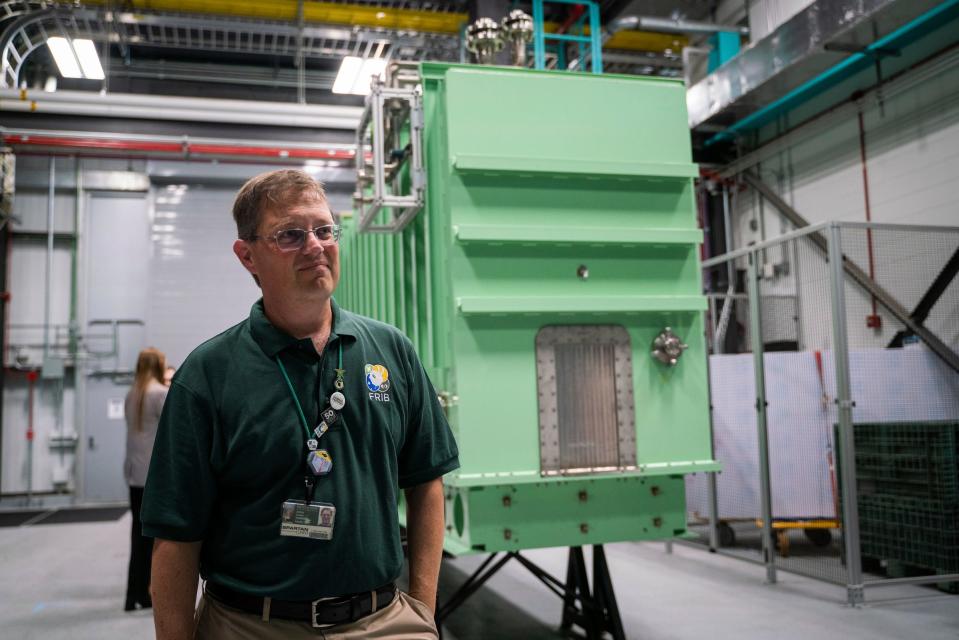
As the stream of ions strikes a target, the resulting collisions cause the ions to lose or gain neutrons or protons and become unstable. This causes them to create thousands of rare isotopes, themselves highly unstable — often existing for only the smallest fraction of a second.
"The ones we are interested in, we can separate them very quickly," Sherrill said. "In a few hundred nanoseconds — a few billionths of a second — we can direct them to the experimental device, catch them and do the measurements."
FRIB requires cryogenics, extreme cold. Conducting this type of activity at room temperature using a common electrical conduit like copper would result in tremendous energy use and loss, as well as damaging heat release, said Ting Xu, director of FRIB's Superconducting Radiofrequency and Superconducting Magnet Department. The method used by FRIB requires 2 to 3 megawatts of power, about 3 million watts; as opposed to a gigawatt of power — 1 billion watts — that would be needed to do the same things at room temperature.
Room temperature would also require a much larger construction to do the same activities — "probably bigger than the MSU campus," Xu said.
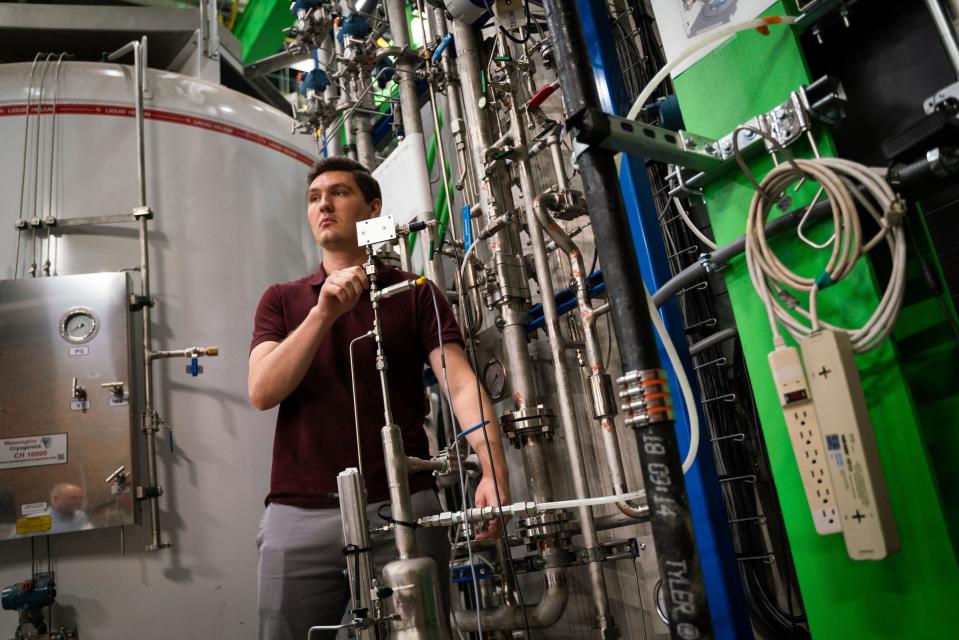
To reach the extremely cold temperatures needed, 4.5 degrees Kelvin, or about minus 450 degrees Fahrenheit, requires the use of liquid helium, the only element that doesn't solidify at that extreme temperature. To meet its need for liquid helium, FRIB built and runs its own helium cryogenic plant, one of the largest helium liquefaction plants anywhere in the world. Most of the cryogenic system infrastructure is designed, fabricated and installed by FRIB staff and students.
"Developing the equipment, that's important. But that's not sufficient if we don't have a skilled workforce," said Nusair Hassan, FRIB senior cryogenics engineer.
MSU has developed a Cryogenic Initiative with its College of Engineering "to train the future cryogenic engineers, system designers and researchers," he said. The skills will also have utility in emerging sectors such as aerospace and quantum computing.
Using the leftovers to fight cancer
When a company, a researcher or the U.S. or a foreign government comes to FRIB looking for answers about a particular rare isotope, the beam creating it often makes thousands of other isotopes not relevant to that experiment.
But MSU chemists are developing a program to work with FRIB, capture and separate those leftover isotopes, and isolate valuable ones for emerging uses in health care and other fields.
"We kind of work in the background and pull out things which we can use to do other experiments," said MSU associate professor of chemistry Greg Severin.
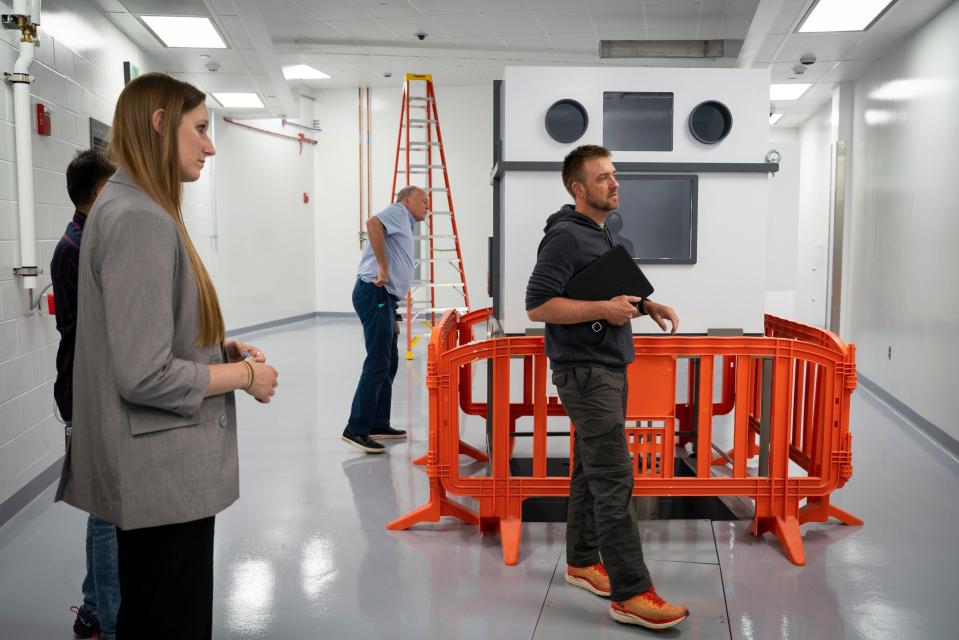
Added Gaiser, "The primary beam at FRIB does not get used, and it gets put into this water pit, where we as radiochemists get to hand-pick whatever we want to play with — which is fantastic."
The medical industry is increasingly interested in using difficult-to-produce radioisotopes in internal radiotherapy, using radioactivity to destroy cancer, Severin said.
"Now that chemistry is so good at targeting the cancers, now we can attach radioisotopes which can ... really pinpoint target the cancer and just do damage to the cancer," he said.
Severin noted research with the rare isotope actinium-225, which has caused a dramatic reduction — "basically an elimination" — of metastatic cancer in patients to whom it has been administered.

"That isotope that people want to use to do this therapy, actinium-225, is exceptionally hard to make," Severin said. "But it's one that gets made as a byproduct of normal operations of FRIB. So our project is to try to pull that out and get it into a useful form so that the clinicians can start getting it into practice."
More: MSU takes aim at cancer with $69M Bio Engineering Facility
Gaiser is also involved MSU Chemistry Department's isotope harvesting program, studying prometheum — that promising, nuclear but non-health-harming battery isotope, also potentially useful for PET imaging in health care. Other radionuclides could be attached to radium "so that we can send it to other parts of the body and treat other forms of cancer" besides bone metastasized cancers for which it now has utility.
The program hopes to be capturing leftover isotopes by next year.
MSU a nuclear science leader since the 1950s
Michigan State University started a nuclear physics program in 1958, and within three years had a National Science Foundation-funded cyclotron, a type of particle accelerator. The world's first superconducting cyclotron, the K500, became operational at MSU in 1982 and upgraded capabilities.
MSU's nuclear physics graduate program has been top-ranked in the U.S. for 28 years, awarding 10% of the nuclear physics doctorate degrees awarded in the country.
But despite that rich history, Glasmacher said he wasn't overly confident as MSU decided to compete for the U.S. Department of Energy Office of Science's request for proposals to construct a facility for rare isotope beams.
"We sent in a 700-page proposal that June, and then we had to go to Maryland and present about 2,000 slides," he said. "They broke us into groups and put us on video."
The proposal had powerful, bipartisan allies in Congress: then-U.S. Sen. Carl Levin, a Democrat; and Republican Rep. Mike Rogers, a member of the House Energy and Commerce Committee who later became chairman of the House Permanent Select Committee on Intelligence.
"Sen. Levin would always tell me, 'Now listen, I can't win this for you. But I can give you a fair chance,' " Glasmacher said.
With support from the state of Michigan, corporations and unions, MSU won the bid for $550 million in federal funds to build FRIB in December 2008. The state and university would contribute nearly $200 million more, much of it involving MSU campus property.
"The industrial infrastructure we have, and also the workforce we have, it was key to our success," Glasmacher said.
'A serendipitous byproduct' — microchip testing
When the federal government provides hundreds of millions of dollars to build your facility, and an additional $120 million a year to help operate it, when it asks for your help with a problem, you do what you can.
The Department of Energy's Office of Science last year asked FRIB whether it could help with a pressing national concern: microchip testing capacity and capability.
"Cosmic rays are heavy ions that bombard us all the time here on Earth," Glasmacher said. "We are exposed to them, but for chips, which are getting smaller and smaller, they can be damaged when a heavy ion hits a piece of silicon just right."
That's problematic for the U.S. military, its satellites, vehicles and other equipment. But also for commercial satellites, cars, and airplanes.
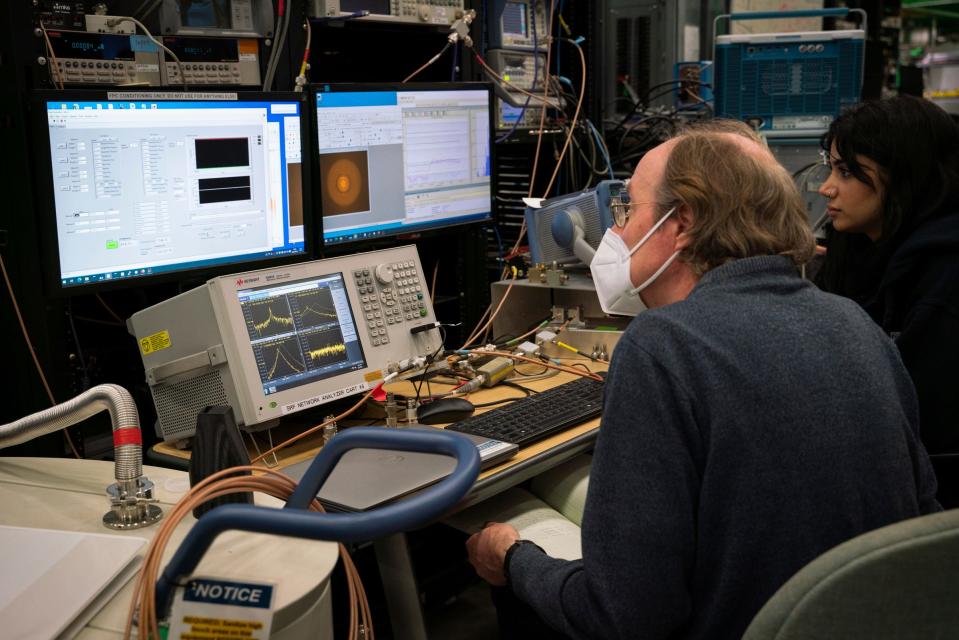
Now, companies such as Boeing, Texas Instruments and Raytheon are using FRIB's facilities to test microchips. It's led to a whole new niche of study: corporate-supported students gaining the education and skills to test microchips, skills with nearly immediate marketability.
With the need ever increasing, the U.S. Department of Defense recently granted MSU $14 million to refurbish its old K500 cyclotron from the early 1980s to facilitate even more microchip testing.
The next generation of cellphones, so-called 6G, will apparently be satellite-based, Glasmacher said. "So they have got to do many more satellites for the next generation of cellphones."
That means more microchips and more chip testing.
"It's a serendipitous byproduct," he said.
Creating future scientists — and finding the occasional prodigy
Maya Wallach is a FRIB veteran. After a summer internship there, she came to MSU to study and work with FRIB as a student last fall. She spent last summer at Los Alamos National Laboratory in New Mexico and this summer at Fermilab in Illinois. She started her master's degree coursework at MSU last semester, and wrote a computer program that uses available data to predict the size of neutrons. That program is now at the foundation of the work of a FRIB-affilated Ph.D. student. "Now we have a full-blown research program that is spawned from" Maya's computer program, said Paul Gueye, an associate professor of physics at MSU.Maya Wallach is 17 years old.
She's an unusually gifted example of FRIB's focus on providing exposure and opportunity for pre-college students to nuclear physics.
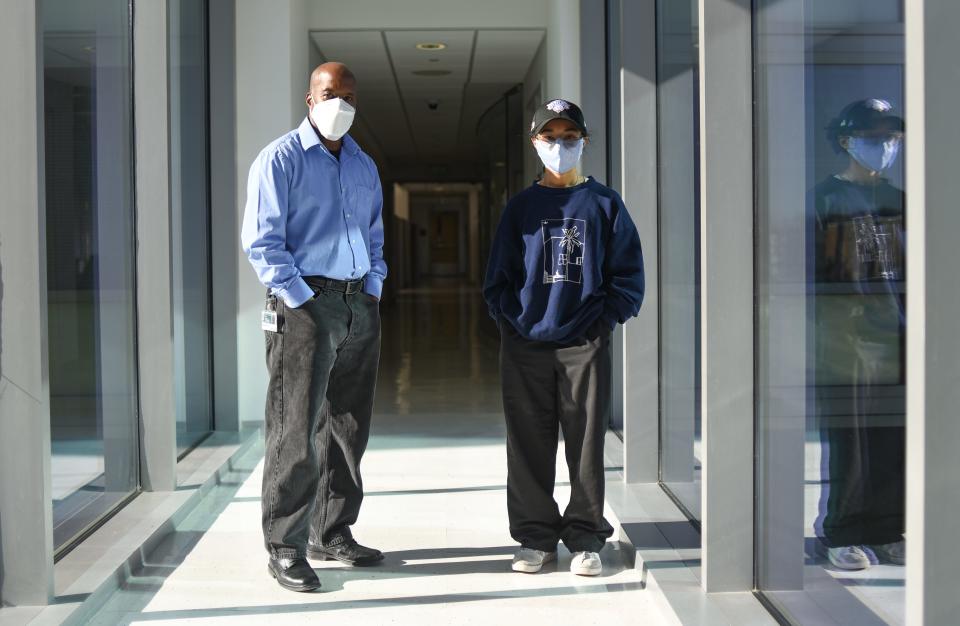
Growing up in a family of educators in Fredricksburg, Virginia, Maya always displayed a thirst for knowledge and a knack for computer programming going back to third grade.
She won a regional science fair as a high school freshman by developing a computer program that studied mass shooters' manifestos and then Twitter data to screen for potential future shooters.
After developing an interest in nuclear and particle physics — but not yet having the advanced math capabilities necessary to fully understand it — Maya wrote computer programs that helped advance her interest.
"What about it appealed to me? I'm not really sure, to be honest," Maya said.
At that point in her exploration, Maya had gone beyond where her parents could take her educationally, Maya's mother, Kenya Wallach, said. "I try to get my kids to have 'educated others' whenever they have something that is of deep interest to them," she said.
The mother reached out to area physicists, and a couple at Virginia Union University who knew Gueye told the Wallachs about him and FRIB. After some online meetings, Maya attended FRIB's PING program, Physicists Inspiring the Next Generation, a two-week summer program exposing high schoolers from around the country to nuclear physics, using undergraduate students at MSU as mentors.
Seeing her potential, Gueye took her under his wing. He initially gave her very elementary physics material, and after she breezed through that, increased the difficulty to material he typically presents to second-year undergraduate students. Maya kept devouring the information with aptitude.
"It was at that point I realized we have somebody here who is not normal," Gueye said.
That's when he reached out to Maya's parents with a startling proposal.
"He told me, 'I think Maya needs to be done with high school. I need her at Michigan State,' " Kenya Wallach recalled.Maya was in the summer before her sophomore year of high school.
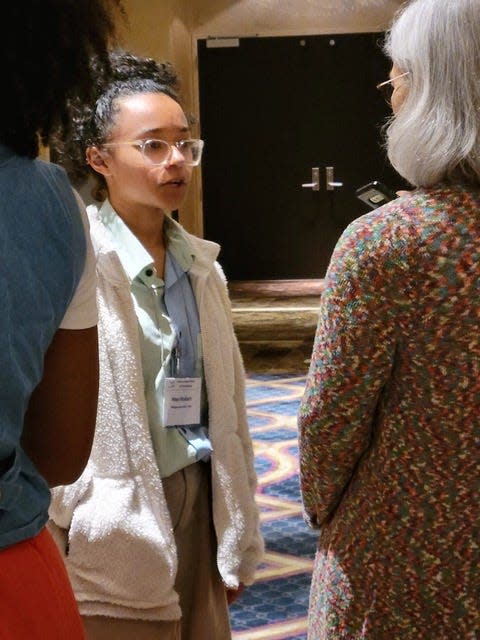
"Of course, I put it into Maya's hands," her mother said. "Maya had to make the decision whether she wanted to do this or not. Yes, she was 14 at the time, but it's her journey; not mine.
"She decided that was something she wanted to explore."
It helped that because of COVID-19 restrictions, Maya finished high school — and the first year-plus of MSU academic coursework — at home with her family's nearby support.
Gueye expects that by next spring, Maya will be completed or nearly completed with her master's degree in physics at Michigan State.
Where are her academic interests leading her professionally? Like many young people around her age, Maya doesn't know yet.
"I try to keep an open mind with what I want to be," she said.
Expanding what is possible in 'the FRIB era'
Since beginning experiments in May 2022, FRIB has created 200 rare isotope beams, supporting nearly 500 experiments. Two research papers from those first experiments have already been published in scientific journals.
The facility utilizes 400 Michigan State staff, 200 students and scores more researchers from around the U.S. and world. FRIB last month announced a collaboration with the French government's Centre National de la Recherche Scientifique to establish the International Research Laboratory on Nuclear Physics and Astrophysics at FRIB. Two French scientists will be stationed in East Lansing long-term to conduct ongoing research.
"The French are really good at nuclear physics, and they want to associate with us and put some of their people here, some of their government-paid researchers, at MSU to make discoveries," Glasmacher said. "We welcome the collaboration. We need the best people in the world to make the best discoveries."
The isotope beam typically operates 24 hours a day, seven days a week, with requests for "beam time" outpacing availability by about 3-to-1. An international panel of experts in nuclear physics helps sift through proposals and prioritize requests.
All told, FRIB has meant a nearly $1.7 billion investment in Michigan, with ongoing annual support from the federal government of $120 million a year, with more than 80% of that expenditure and economic impact staying in the Great Lakes State, Glasmacher said.
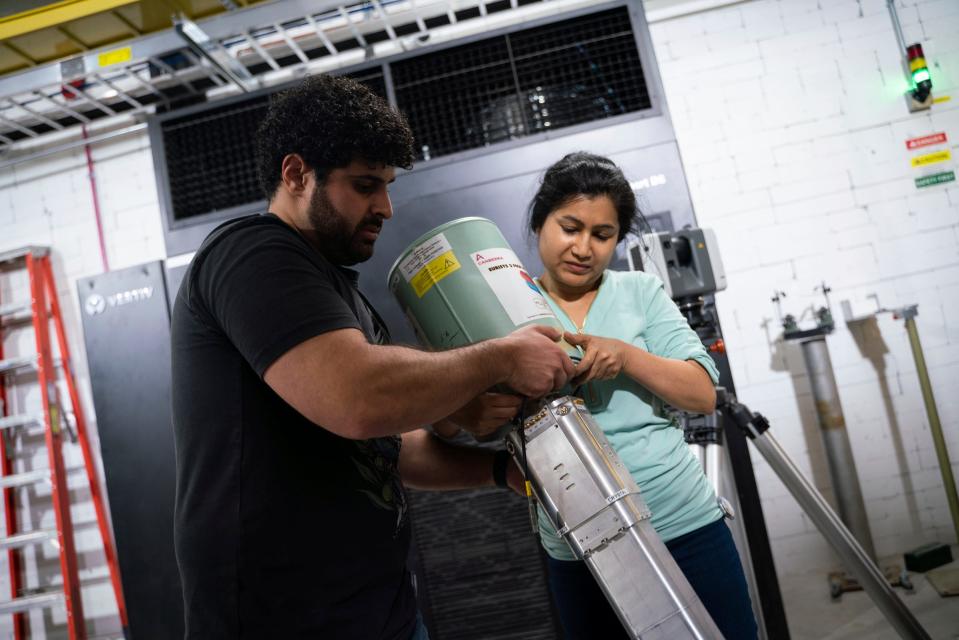
As FRIB expands what can now be known about atomic nuclei and the origins of elements in the universe, FRIB officials have already begun planning for an even more powerful rare isotope beam, years down the road, that will enable even more discovery.
"In a lot of the meetings with scientists, the discussion has moved toward what kind of new science can we do now that FRIB is available — even using the words, 'in the FRIB era,' " Severin said.
"So it's my impression it has made quite a stir in the community."
Contact Keith Matheny: kmatheny@freepress.com.
This article originally appeared on Detroit Free Press: MSU's Facility for Rare Isotope Beams probes atom's, universe's secrets

